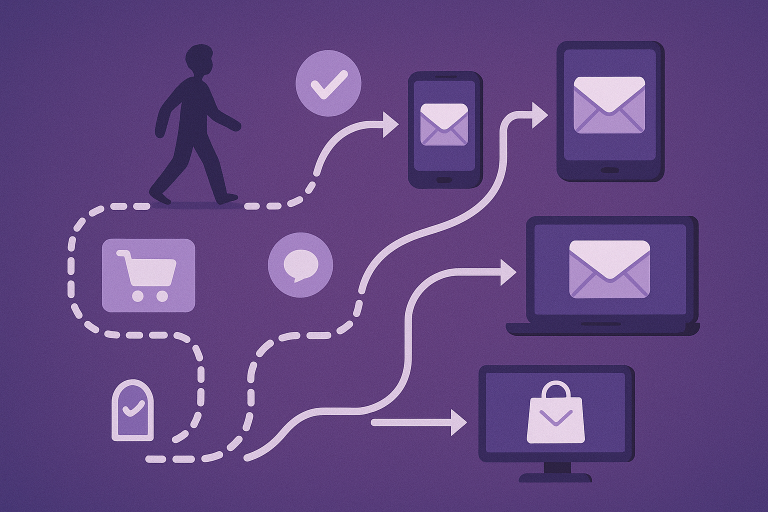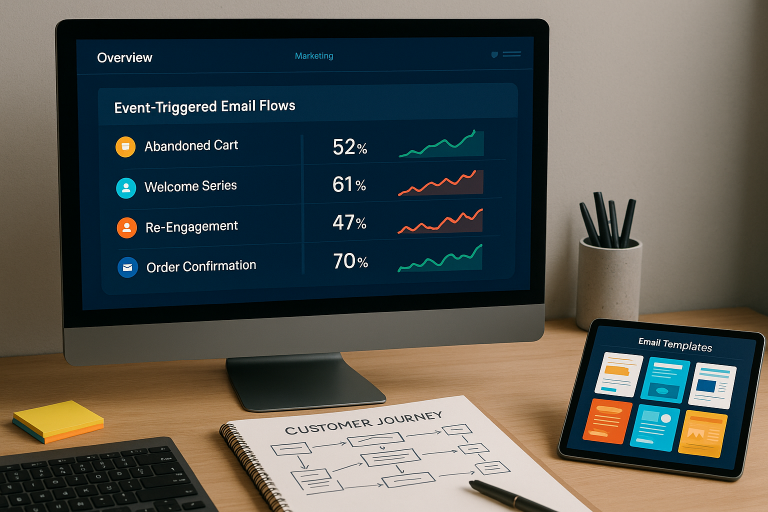How Event-Triggered Email Flows Drive Customer Engagement
In today’s digital landscape, generic mass email campaigns are becoming less effective as customers expect more personalized and relevant communication. Event-triggered email flows represent a powerful evolution in email marketing strategy, delivering timely messages based on specific customer actions or behaviors. When implemented correctly, these automated sequences can significantly boost engagement, conversions, and customer loyalty while reducing the workload on your marketing team.
Let’s explore how you can harness the power of event-triggered email automation to transform your customer relationships and drive business results.

Understanding Event-Triggered Email Automation
Before jumping into implementation strategies, it’s essential to understand what makes event-triggered emails different from traditional campaigns and why they’ve become so crucial to effective digital marketing.
What Are Event-Triggered Emails?
Event-triggered emails (also called behavioral emails) are automated messages sent in response to specific user actions or events. Unlike scheduled batch emails that go out to an entire list at once, triggered emails are activated individually when a customer takes a particular action or meets certain criteria.
These messages typically include:
- A trigger – The specific event that initiates the email
- Timing parameters – When the email should be sent after the trigger occurs
- Personalized content – Relevant information based on the triggering action
- Clear call-to-action – What you want the recipient to do next
The key distinction between traditional and triggered email campaigns lies in their activation method. While traditional campaigns operate on a predetermined schedule, triggered emails respond dynamically to customer behavior, creating more contextually relevant interactions.
Common trigger types include:
Trigger Category | Examples | Typical Response Time |
Behavioral | Cart abandonment, product views, content downloads | Minutes to hours |
Transactional | Purchases, sign-ups, account changes | Immediate to minutes |
Time-based | Membership anniversaries, renewals, birthdays | Scheduled (often days in advance) |
Lifecycle | Onboarding milestones, engagement changes | Hours to days |
Benefits of Event-Based Email Marketing
Implementing event-triggered email flows offers numerous advantages over traditional email marketing approaches:
- Higher engagement rates – Triggered emails can achieve open rates 3-5 times higher than regular promotional emails because they arrive when the topic is most relevant to recipients
- Increased conversion potential – By responding to specific customer intent signals, these emails can achieve conversion rates up to 10 times higher than standard campaigns
- Enhanced customer experience – Customers receive timely, helpful information precisely when they need it, rather than random promotional content
- Resource efficiency – Once set up, these automations run continuously without requiring constant manual intervention from your team
- Scalability advantages – The same event-triggered system works whether you have 100 or 1,000,000 customers, with minimal additional resource requirements as you grow
As our research into automated marketing solutions shows, businesses implementing well-designed event-triggered email flows typically see a 20-30% increase in revenue from their email marketing efforts.
Essential Event Triggers Every Marketer Should Implement
While the specific triggers that work best will vary by industry and business model, certain event-triggered email flows consistently deliver strong results across sectors. Let’s explore the most valuable trigger categories to consider for your automation strategy.
Behavioral Triggers
Behavioral triggers respond directly to how customers interact with your digital properties. These are often the highest-converting triggered emails because they address immediate customer interests or pain points:
- Abandoned cart recovery – Emails sent when customers add products to their cart but leave without completing purchase (typically sent 1-24 hours after abandonment)
- Product browsing follow-up – Targeted messages based on specific product categories or items a customer has viewed multiple times
- Search abandonment – Emails triggered when customers search for products but don’t find or select results
- Content engagement – Follow-ups based on interaction with specific content pieces (blog articles, videos, tools) to nurture interest in related topics
- Post-purchase sequence – A series of emails following a purchase to encourage product usage, cross-sell complementary items, or request reviews
Lifecycle Triggers
Lifecycle triggers mark important moments in the customer relationship with your brand. These emails help guide customers through different stages of their journey:
- Welcome series – A sequence introducing new subscribers to your brand, typically 3-5 emails over 1-2 weeks
- Onboarding flows – Step-by-step guidance helping new customers achieve initial success with your product or service
- Milestone celebrations – Recognizing anniversaries, birthdays, or achievement of goals within your product
- Renewal reminders – Notifications about upcoming subscription renewals or membership expirations
- Re-engagement campaigns – Attempts to reconnect with customers whose engagement has declined over time
“The most effective lifecycle emails don’t just mark occasions—they create genuine moments of connection that strengthen the customer relationship.”
Transactional Triggers
Transactional emails are triggered by specific business processes or customer-initiated actions. While primarily functional, these emails present valuable opportunities for relationship building:
- Order confirmations – Immediate verification of purchase details
- Shipping notifications – Updates on order fulfillment and delivery status
- Account changes – Confirmations of modifications to customer account information
- Payment receipts – Documentation of completed financial transactions
- Service notifications – Updates about changes to services, maintenance periods, or other operational information
Transactional emails typically have the highest open rates of any email type—often exceeding 80%—making them valuable touchpoints for strengthening customer relationships beyond their functional purpose.

Building Effective Event-Based Marketing Automation
Successfully implementing event-triggered email flows requires thoughtful planning and strategic execution. Here’s how to build a foundation for effective automation:
Mapping the Customer Journey
Before creating individual email triggers, develop a comprehensive understanding of your customer journey:
- Document key touchpoints – Identify all significant interactions customers have with your brand
- Identify critical moments – Determine which points represent opportunities for timely, relevant communication
- Understand emotional context – Consider the customer’s mindset at each potential trigger point
- Define desired outcomes – Clarify what action you want the customer to take after receiving each triggered email
This mapping process reveals natural trigger points where automated emails can provide the most value to both customers and your business.
Setting Up Technical Infrastructure
Implementing event triggers requires appropriate technical capabilities:
- Event tracking – Configure your website and applications to record relevant user actions
- Data collection – Ensure customer behavior data flows properly into your marketing platform
- CRM integration – Connect your email automation with your customer database for personalization
- Privacy compliance – Verify all data collection and usage meets relevant regulations (GDPR, CCPA, etc.)
Most modern email marketing platforms offer built-in capabilities for event tracking and automation, though more complex implementations may require developer support.
Creating Compelling Email Content
Even the most perfectly timed trigger email will fail without relevant, engaging content:
- Maintain contextual relevance – Content should directly address the triggering action or event
- Personalize thoughtfully – Use available data to customize the message beyond just inserting the recipient’s name
- Craft clear CTAs – Each email should guide recipients toward a specific next step
- Design for all devices – Ensure your emails display properly across desktop, mobile, and tablet
- Test thoroughly – Verify that all personalization elements, links, and dynamic content function correctly
Remember that event-triggered emails should feel like a natural continuation of the customer’s interaction with your brand—not like an unrelated marketing message.
Leveraging AI in Event-Triggered Campaign Flows
Artificial intelligence is revolutionizing what’s possible with event-triggered email automation. By incorporating AI capabilities, marketers can create more sophisticated, personalized experiences at scale.
Predictive Analytics in Email Automation
AI-powered predictive analytics can transform how you determine when and what to send:
- Next-best-action models – Algorithms that predict the most effective follow-up for each individual customer
- Churn prediction – Identifying customers showing early warning signs of disengagement
- Purchase propensity scoring – Calculating which customers are most likely to buy specific products
- Lifetime value forecasting – Predicting long-term customer value to inform investment in specific customer relationships
These predictive capabilities allow for more precise targeting and better allocation of marketing resources to high-potential opportunities.
AI-Powered Content Optimization
AI can significantly improve email content performance through:
- Subject line optimization – Predicting which subject lines will generate the highest open rates for different segments
- Send time personalization – Delivering emails when each individual recipient is most likely to engage
- Content recommendations – Dynamically inserting the most relevant products or content based on customer behavior patterns
- Automated A/B testing – Continuously testing and optimizing email elements without manual intervention
For marketers looking to implement advanced AI capabilities in their marketing automation, GIBION’s AI solutions provide powerful tools that integrate with existing marketing stacks.
Intelligent Segmentation and Targeting
Beyond basic triggers, AI enables more sophisticated audience targeting:
- Behavioral clustering – Automatically grouping customers with similar interaction patterns
- Propensity-based targeting – Focusing on customers with the highest likelihood of conversion
- Content affinity analysis – Understanding which content topics resonate with different customer segments
- Cross-channel coordination – Synchronizing email triggers with messaging in other channels
These advanced targeting capabilities ensure that your triggered emails reach the right people with the right message at the optimal moment.
Measuring Success in Event-Triggered Email Marketing
Implementing triggered emails is just the beginning—continuous measurement and optimization are essential for long-term success.
Performance Metrics That Matter
Focus on these key metrics when evaluating your event-triggered email performance:
Metric Category | Key Measurements | Benchmark Comparison |
Engagement Metrics | Open rate, click-through rate, click-to-open ratio | Compare to your broadcast emails and industry benchmarks |
Conversion Metrics | Conversion rate, revenue per email, average order value | Compare across different trigger types |
Program Impact | Revenue attribution, customer lifetime value impact | Compare customers who receive vs. don’t receive triggered emails |
Technical Performance | Delivery rate, trigger accuracy, timing precision | Monitor trends over time |
When analyzing performance, evaluate each trigger sequence separately rather than aggregating all triggered emails together, as different types of triggers serve different purposes and should be held to appropriate standards.
Testing and Optimization Strategies
To continuously improve your event-triggered emails:
- Test trigger timing – Experiment with different delays between the trigger event and email delivery
- Optimize sequence structure – Test different numbers of emails and spacing between messages
- Refine content approach – Try different messaging strategies, creative treatments, and offers
- Adjust segmentation rules – Experiment with more or less granular targeting criteria
- Review trigger criteria – Periodically reassess which events should activate email sequences
Document your testing hypotheses and results to build an organizational knowledge base about what works best for your specific audience.
Conclusion: The Future of Event-Triggered Email Marketing
Event-triggered email flows represent the intersection of automation efficiency and personalized customer experience. By delivering timely, relevant messages based on specific customer actions, these automated sequences create more meaningful connections while driving measurable business results.
As AI capabilities continue to advance, the potential for even more sophisticated trigger-based marketing will expand. Organizations that build strong foundations now—with clear customer journey mapping, solid technical implementation, and ongoing optimization—will be best positioned to leverage these future innovations.
Ready to transform your email marketing strategy with powerful event-triggered automation? Start by identifying your highest-potential trigger opportunities, implementing the technical foundations, and creating compelling content sequences that guide customers toward deeper engagement with your brand.
Remember that the most successful event-triggered emails don’t just drive transactions—they create genuinely helpful, personalized experiences that customers appreciate and respond to. When you achieve that balance, both your metrics and your customer relationships will reflect the difference.
